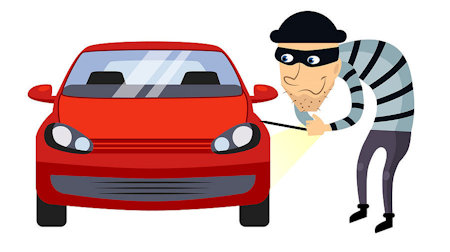


Mobile users:
For best results, view in Landscape mode.
Lock your car and take the
key with you.
The majority of stolen cars are left unlocked, often
with the keys in the ignition.
Whether you leave it for a moment or for several hours,
always lock it and take the keys with you.
Never leave your car with the engine running.
This is an open invitation for a thief.
Secure your valuables:
Most car break-ins occur because something of value
is left in the car.
You can prevent most car break-ins by keeping your
valuables and belongings out of sight.
Never leave your personal stuff unattended in your car,
such as:
cell phone, laptop, or or other electronics, loose change,
other cash, wallet, purse, credit / debit cards, cigarettes,
etc.
It only takes a thief a few seconds to break a window and
grab your personal belongings.
Lock valuables in the trunk or take them with you.
If you have to leave belongings in your car’s back seat,
put them on the floor and cover them with a towel
or blanket to conceal them.
But use a towel or blanket that doesn’t draw attention to
your car or make it obvious that it’s covering
something of value.
Install a good quality car alarm:
Today's car alarms can include options such as:
motion sensors, knock sensors or an annoying siren
if there is any unauthorized entry into your car, opening
of the hood, or entry into the trunk.
If you are unable to afford a good car alarm system for
some reason, you can purchase car alarm stickers
that you can stick on your car windows indicating you
have a car alarm when actually you don't.
You can also purchase an LED flashing
light dash mount fake car alarm for
low cost.
Park in Well-Lit and Busy Areas:
Always park in well-lit areas and as close to your destination
as possible.
This is important for both your personal safety and the
protection of your car and its contents.
Most criminals don't like to make a scene and will avoid
busy locations.
If you're alone and have concerns for any reason,
ask someone in the store to escort you to your car.
Most people are willing to help.
Always be aware of your surroundings:
Keep your eyes open and your hands free.
Don’t let your schedule compromise your situational
awareness.
This is especially important while you're walking to
your car.
Scan the area before you leave your car and as you walk
back to it.
Always check your back seat before getting into your car.
If anything makes you feel uncomfortable, change
accordingly.
If you feel that you are being followed, go to a busy place
or the nearest police station.
The more witnesses you can put yourself in the middle of,
the less likely the criminal will act.
Try to get a good description of who is following you if it
is safe to do so.
If you stop at an ATM, make it a quick visit.
Scan the area around the ATM before approaching it.
Make sure that the area around the ATM is well lit.
Try to select an ATM in a busy location.
Danger prefers darkness, so if you can, only withdraw money
during the day.
Do not linger putting your card away, counting your money,
examining your receipt, etc.
If someone is at or near the ATM makes you uneasy, leave
and go to another ATM.
Any time you have to use any kind of force in self-defense,
call 911 as soon as it is safe to do so and report what
happened.
The person who is first to contact the police is usually
considered the “victim” of an incident.
If the would-be carjacker or mugger you just thwarted gets
to a phone before you do and starts telling stories
about a “crazy man or woman with a gun,” your day could
get even worse very quickly.
So make sure that you contact the police as soon as
possible.

